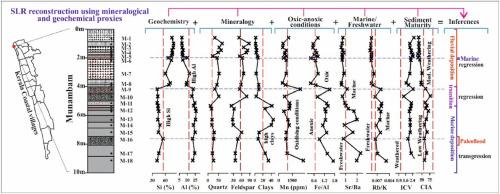沉积物岩心的矿物学和地球化学指标,以了解印度西南海岸的古气候和海平面变化
IF 3.4
3区 地球科学
Q1 GEOCHEMISTRY & GEOPHYSICS
引用次数: 0
摘要
除其他因素外,地球化学变化可归因于空气、水和陆地的相互作用,这些因素在沿海环境中很丰富。为了探讨这些相互作用在印度西南部Vypin岛的程度,研究了三个沉积物岩心的矿物学和地球化学变化。Kuzhuppilly岩心长~ 10 m,砂层厚9 m,表明存在屏障后脊条件,主要受河流作用的影响。矿物学特征显示弱风化特征,而地球化学特征显示干旱条件,导致沉积在25-145 cm, 350-365 cm和940-955 cm深度断裂,通过去除轻Si和富al物质富集Fe, Ti, Zr和Mn。在Chellanam和Munambam岩心中,特征粘土和砂层分别表明底部和顶部有两种不同的沉积。海绿石和高岭石的存在进一步补充了较高海平面下的盐性和氧性沉积条件,这些沉积条件在内陆架沉积环境中发现的底部粘土沉积物中。顶部的砂质沉积物是在淡水条件下(Sr/Ba)沉积的,但受到缺氧条件的侵入,Fe/Al值表明河流改造或沉积。蚀变化学指标表明,从Kuzhuppilly到Chellanam和Munambam,沉积成熟度呈上升趋势,Munambam在~ 5.5 m深度有沉积间断。此外,海绿石和高岭石表明深层沉积物的渐进风化作用。研究表明,在高海平面时期,粘土质沉积物在陆架内部沉积,而在半干旱气候条件下,砂和粘土之间的富微量元素层表明,在低海平面时期,砂质沉积物在主要河流作用下会进一步沉积和再加工。该研究确认了三个干旱阶段的特征,每个阶段的回归事件和由粘土-砂混合沉积层支持的古洪水事件。本文章由计算机程序翻译,如有差异,请以英文原文为准。

Mineralogical and geochemical proxies from sediment cores to understand paleoclimate and sea level changes along the southwest coast of India
Geochemical variations, among other factors, are attributable to air, water, and land interactions, which are plentiful in the coastal setting. To explore the extent of these interactions in the Vypin Island, southwest of India, three sediment cores were investigated for the mineralogical and geochemical variations. A ∼10 m long core from Kuzhuppilly with a 9 m thick sand deposit suggested a back-barrier ridge condition, largely influenced by fluvial processes. Mineralogy indicated a weakly weathered character, while geochemistry suggested arid conditions, causative of a break in sedimentation at 25–145 cm, 350–365 cm, and 940–955 cm depths with enrichment of Fe, Ti, Zr, and Mn by removal of light-weight Si and Al-rich material. In Chellanam and Munambam cores, characteristic clay and sand layers suggest two varied depositions at the bottom and top, respectively. Saline and oxic depositional conditions under higher sea levels are further complemented by presence of glauconite and kaolinite in bottom clayey sediments, found in the inner shelf depositional setting. The sandy sediments on top are deposited under freshwater conditions (Sr/Ba) but intruded by anoxic conditions indicated by Fe/Al values suggesting a fluvial reworking or deposition. Chemical index of alteration delineate increasing sediment maturity trend from Kuzhuppilly to Chellanam, and Munambam with a depositional hiatus at ∼5.5 m depth in Munambam. Further, glauconite and kaolinite suggest progressive weathering of deeper sediments. This study suggests that clayey sediments were deposited under inner-shelf conditions during higher sea levels, and a trace elemental rich layer between sand and clay proposes further sandy sediment deposition and reworking by dominant fluvial processes during lower Sea levels under semi-arid climate. The work recognizes signatures of three arid phases, regression episodes each and paleo-flood events supported by clay-sand mixed sediment layers.
求助全文
通过发布文献求助,成功后即可免费获取论文全文。
去求助
来源期刊

Applied Geochemistry
地学-地球化学与地球物理
CiteScore
6.10
自引率
8.80%
发文量
272
审稿时长
65 days
期刊介绍:
Applied Geochemistry is an international journal devoted to publication of original research papers, rapid research communications and selected review papers in geochemistry and urban geochemistry which have some practical application to an aspect of human endeavour, such as the preservation of the environment, health, waste disposal and the search for resources. Papers on applications of inorganic, organic and isotope geochemistry and geochemical processes are therefore welcome provided they meet the main criterion. Spatial and temporal monitoring case studies are only of interest to our international readership if they present new ideas of broad application.
Topics covered include: (1) Environmental geochemistry (including natural and anthropogenic aspects, and protection and remediation strategies); (2) Hydrogeochemistry (surface and groundwater); (3) Medical (urban) geochemistry; (4) The search for energy resources (in particular unconventional oil and gas or emerging metal resources); (5) Energy exploitation (in particular geothermal energy and CCS); (6) Upgrading of energy and mineral resources where there is a direct geochemical application; and (7) Waste disposal, including nuclear waste disposal.
 求助内容:
求助内容: 应助结果提醒方式:
应助结果提醒方式:


